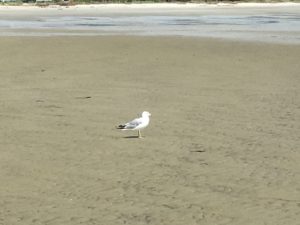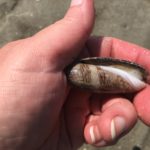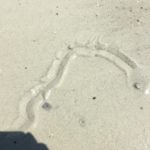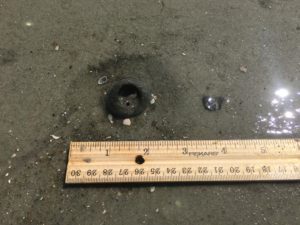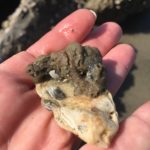What you see on a beach walk on this beautiful island can vary so greatly, depending on which beach you start from, the season, the tides, and whether there has been a recent storm to churn things up. I love taking folks out to see what we can discover on the beach, but formal programs cover so little of my time exploring this island so I thought I’d add a virtual beach walk and share what I find. Let me know what you think of this feature in the comments.
It has been raining for days and I was getting stir crazy, even this reader can only read so much. Finally we got a break in the weather today and I headed out this morning just after low tide. I had not actually been to the heel of the island in a few months (terrible!!), so I knew that was where I was going. What follows are photos of some of the things I saw today and some information that I might have shared if we were exploring together.
- I found 3 Colorful Sea Whips washed up on the beach, a common finding after so much rain.
- Sea Whips are the most commonly found soft coral on the island.
- I found a few fully intact whelk egg cases. All were for the Knobbed Whelk.
- Identified by the flat edged of the egg capsules. You can see the holes where the babu whelks emerged from the capsules.
Many birds, but surprisingly, no Great Blue Herons or Brown Pelicans.
- Snowy Egret
- Tricolored Heron
- Ring Billed Gull
- Laughing Gull
- Willet
- Little Blue Heron
I followed some tracks in the sand…
- No mistaking this trail…
- The Lettered Olive, the state shell of South Carolina.
- So named because the marking on the shell look like letters.
- No mistaking this one either…
- The Sharkeye Moon Snail.
- Here you can see the golden operculum that the snail uses to seal itself in the shell.
I found quite a few Lettered Olives and Sharkeyes,pretty easy to find at low tide, but the most interesting track I found today belongs to this…
- A Knobbed Whelk Shell, but notice the tracks. Not the slithering or burrowing of a snail, but the skittering tracks of the new occupant, a good sized hermit crab.
- But more interesting than the hermit crab is the number of other critters living on this shell. Here you can see that the inside lip is filled with slipper snails.
- On the end of the shell you can see a Hitchhiker Anemone.
- And on the outside of the shell are barnacles and more slipper snails. A darn critter community!!
And as usual, lots of dead crabs…
- Small Blue Crab, intact.
- By looking at the apron we can see that this was a male, note the “Washington Monument:.
- Juvenile female Blue crab, identified by the inverted “V” shaped apron.
- I think we can tell hoe she died.
- Intact Ghost Crab…
- and a pretty danred good sized one.
you’ve all probably seen the holes on the beach surrounded by what looks like chocolate sprinkles. Some of you probably even know that those holes are the burrows for ghost shrimp. And the chocolate sprinkles? Just suffice it to say that they aren’t chocolate 🙂 But did you know that there are two types of ghost shrimp common to the island? The are the Carolinian (appropriate) and the Georgian, with the Carolinian being the much larger of the two and making larger burrows. Geologists love ghost shrimp burrows because these easily fossilize, and the following photos may give you some indication as to why.
- The sand has eroded away from the entrance of this old burrow.
- The top portion of the burrow can be popped quite easily from the sand.
- No more shrimp occupant means the burrow fills with silt and small shells.
- Here I have broken it open. But imagine, this was sturdy enough that I could hold it.
Some worms, well, their tubes anyway…
- Sandbuilder Worm tubes on an oyster shell.
- The top of a Plumed (Decorator) Worm tube extending out from the sand.
- Soda Straw Worm tubes dislodged from the sand.
And to finish, some random things I found today…
- A bunch of hermit crabs collected at the jetty at the heel of the island. Low tide is a great time to find them here,
- A Gray (Lined) Sea Star. This individual was still alive so put into the water.
- A Red Algae, aka, seaweed.
- An eastern Oyster Drill
- Jackknife Clam, a kind of razor clam.
- A vertebrae from a yet unidentified critter.
- Blood Ark, with the evidence of it’s demise.
- The molt of a Horseshoe Crab.









